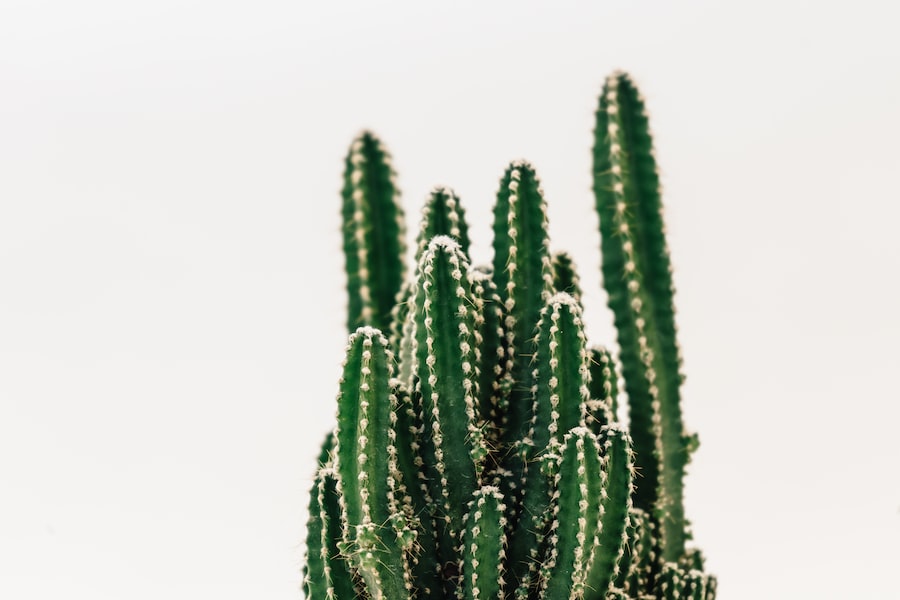Why Is My Rubber Tree Plant Losing Leaves? Understanding the Causes and Solutions

Rubber tree plants, also known as Ficus elastica, are popular houseplants known for their large, glossy leaves and ability to purify the air. They are native to Southeast Asia and are commonly grown as indoor plants in many parts of the world. Rubber tree plants can grow up to 30 meters tall in their natural habitat, but when grown indoors, they typically reach a height of 2-3 meters.
Maintaining healthy leaves is crucial for the overall health and appearance of rubber tree plants. Leaves play a vital role in photosynthesis, the process by which plants convert sunlight into energy. They also help regulate water loss through transpiration and provide a barrier against pests and diseases. Therefore, it is important to address any issues that may cause leaf loss in rubber tree plants.
Key Takeaways
- Rubber tree plants are popular houseplants known for their large, glossy leaves and easy care.
- Leaf loss is a common issue with rubber tree plants and can be caused by a variety of factors.
- Overwatering or underwatering can both lead to leaf loss in rubber tree plants.
- Environmental factors such as low light or cold temperatures can also cause leaf loss.
- Pests, diseases, nutrient deficiencies, overfertilization, improper pruning, and repotting can all contribute to leaf loss in rubber tree plants.
Common Symptoms of Leaf Loss in Rubber Tree Plants
Yellowing leaves are one of the most common symptoms of leaf loss in rubber tree plants. This can be caused by a variety of factors, including overwatering, underwatering, nutrient deficiencies, or environmental stress. When leaves turn yellow, it is often a sign that the plant is not receiving enough water or nutrients.
Brown spots on the leaves can also indicate leaf loss in rubber tree plants. These spots can be caused by fungal infections or pest infestations. If left untreated, the brown spots can spread and eventually cause the affected leaves to drop.
Wilting leaves are another symptom of leaf loss in rubber tree plants. This can occur when the plant is not receiving enough water or when it is exposed to extreme temperatures or low humidity levels. Wilting leaves can also be a sign of root rot, which is caused by overwatering and poor drainage.
Leaf drop is the most obvious symptom of leaf loss in rubber tree plants. This can occur for various reasons, including environmental stress, pest infestations, nutrient deficiencies, or improper care. When leaves start to drop, it is important to identify the underlying cause and take appropriate action to prevent further leaf loss.
Watering Issues and Leaf Loss in Rubber Tree Plants
Overwatering is a common issue that can lead to leaf loss in rubber tree plants. When the soil is constantly wet, it can cause the roots to rot, leading to poor nutrient uptake and leaf drop. It is important to allow the top inch of soil to dry out before watering again. This will help prevent overwatering and promote healthy root growth.
On the other hand, underwatering can also cause leaf loss in rubber tree plants. When the plant does not receive enough water, it will start to conserve moisture by shedding its leaves. It is important to water the plant thoroughly whenever the top inch of soil feels dry to the touch.
Proper drainage is essential for preventing water-related issues and leaf loss in rubber tree plants. The plant should be potted in a well-draining soil mix and placed in a pot with drainage holes. This will allow excess water to escape and prevent water from pooling at the bottom of the pot.
Environmental Factors That Can Cause Leaf Loss in Rubber Tree Plants
| Environmental Factor | Cause of Leaf Loss |
|---|---|
| Temperature | Extreme heat or cold can cause leaf drop |
| Humidity | Low humidity can cause leaf loss |
| Watering | Overwatering or underwatering can cause leaf drop |
| Light | Insufficient or excessive light can cause leaf loss |
| Nutrition | Deficiencies or excesses in nutrients can cause leaf drop |
| Pests | Infestations of pests such as spider mites or mealybugs can cause leaf loss |
Temperature fluctuations can cause leaf loss in rubber tree plants. These plants prefer temperatures between 60-75°F (15-24°C) and can be sensitive to extreme heat or cold. Exposure to temperatures outside of their preferred range can cause stress and lead to leaf drop. It is important to keep rubber tree plants away from drafty windows or doors and avoid placing them near heating or cooling vents.
Humidity levels can also affect rubber tree plants and cause leaf loss. These plants prefer moderate to high humidity levels, around 50-60%. In dry indoor environments, the leaves may start to dry out and drop. To increase humidity, you can mist the leaves regularly or place a humidifier near the plant.
Light exposure is another environmental factor that can cause leaf loss in rubber tree plants. These plants prefer bright, indirect light. If they are exposed to direct sunlight for extended periods, the leaves can become scorched and drop. On the other hand, if they do not receive enough light, the leaves may turn yellow and fall off. It is important to find a balance and provide the plant with the right amount of light.
Pests and Diseases That Can Cause Leaf Loss in Rubber Tree Plants
Spider mites are a common pest that can cause leaf loss in rubber tree plants. These tiny insects feed on the sap of the leaves, causing them to turn yellow and eventually drop. Spider mites thrive in dry conditions, so increasing humidity and regularly inspecting the plant for signs of infestation can help prevent leaf loss.
Mealybugs are another common pest that can affect rubber tree plants. These small, white insects feed on the sap of the leaves and stems, causing them to wilt and drop. Mealybugs can be difficult to eliminate, so it is important to regularly inspect the plant for signs of infestation and take immediate action if necessary.
Fungal infections can also cause leaf loss in rubber tree plants. Overwatering or high humidity levels can create a favorable environment for fungal growth. Common fungal infections include leaf spot and powdery mildew, which can cause brown spots or a white powdery coating on the leaves. Fungal infections should be treated promptly to prevent further leaf loss.
Nutrient Deficiencies and Leaf Loss in Rubber Tree Plants

Lack of nitrogen is a common nutrient deficiency that can cause leaf loss in rubber tree plants. Nitrogen is essential for healthy leaf growth, and a lack of it can cause the leaves to turn yellow and drop. To address this issue, you can use a balanced fertilizer that contains nitrogen or apply a nitrogen-rich organic amendment.
Lack of potassium can also lead to leaf loss in rubber tree plants. Potassium is important for overall plant health and helps regulate water uptake and nutrient transport. A deficiency in potassium can cause the leaves to develop brown spots and eventually drop. To address this issue, you can use a fertilizer that is specifically formulated for foliage plants and contains a balanced ratio of nutrients.
Lack of magnesium is another nutrient deficiency that can cause leaf loss in rubber tree plants. Magnesium is essential for chlorophyll production and photosynthesis. A deficiency in magnesium can cause the leaves to turn yellow and drop. To address this issue, you can apply a magnesium-rich fertilizer or use Epsom salt as a foliar spray.
Overfertilization and Leaf Loss in Rubber Tree Plants
Overfertilization can cause leaf loss in rubber tree plants. When plants are exposed to excessive amounts of fertilizer, it can lead to nutrient imbalances and toxicity. Signs of overfertilization include yellowing or browning of the leaves, wilting, and leaf drop. It is important to follow the instructions on the fertilizer package and avoid overfertilizing the plant.
Pruning and Leaf Loss in Rubber Tree Plants
Pruning is an important aspect of maintaining healthy rubber tree plants and can help prevent leaf loss. Regular pruning helps remove dead or diseased leaves, promotes new growth, and improves air circulation around the plant. It is important to use clean, sharp pruning shears and make clean cuts just above a leaf node or bud.
To properly prune a rubber tree plant, start by removing any dead or yellowing leaves. Then, trim back any leggy or overgrown branches to promote a more compact growth habit. It is also important to remove any branches that are crossing or rubbing against each other. Finally, shape the plant by cutting back any branches that are growing in an undesirable direction.
Repotting and Leaf Loss in Rubber Tree Plants
Knowing when to repot a rubber tree plant is important for preventing leaf loss. These plants generally need to be repotted every 2-3 years, or when they outgrow their current pot. Signs that a rubber tree plant needs to be repotted include roots growing out of the drainage holes, the plant becoming top-heavy, or the soil drying out quickly after watering.
When repotting a rubber tree plant, it is important to choose a pot that is slightly larger than the current one. This will allow room for the roots to grow and prevent them from becoming root-bound. It is also important to use a well-draining soil mix that is specifically formulated for indoor plants. This will help prevent overwatering and root rot.
Tips for Preventing and Treating Leaf Loss in Rubber Tree Plants
To prevent leaf loss in rubber tree plants, it is important to regularly check for pests and diseases. Inspect the leaves and stems for any signs of infestation or infection, such as yellowing, wilting, or discoloration. If pests or diseases are detected, take immediate action to treat the problem and prevent further leaf loss.
Proper watering and fertilization are also crucial for maintaining healthy rubber tree plants. Water the plant thoroughly whenever the top inch of soil feels dry to the touch, and ensure that the pot has proper drainage. Use a balanced fertilizer that is specifically formulated for foliage plants and follow the instructions on the package.
Pruning and repotting as needed are important for promoting healthy growth and preventing leaf loss in rubber tree plants. Regularly inspect the plant for any dead or yellowing leaves and remove them promptly. Repot the plant every 2-3 years or when it outgrows its current pot, using a well-draining soil mix and a slightly larger pot.
If leaf loss persists despite proper care, it may be necessary to seek professional help. A plant specialist or horticulturist can provide guidance and diagnose any underlying issues that may be causing leaf loss in rubber tree plants. They can recommend specific treatments or adjustments to care routines to help restore the plant’s health.



